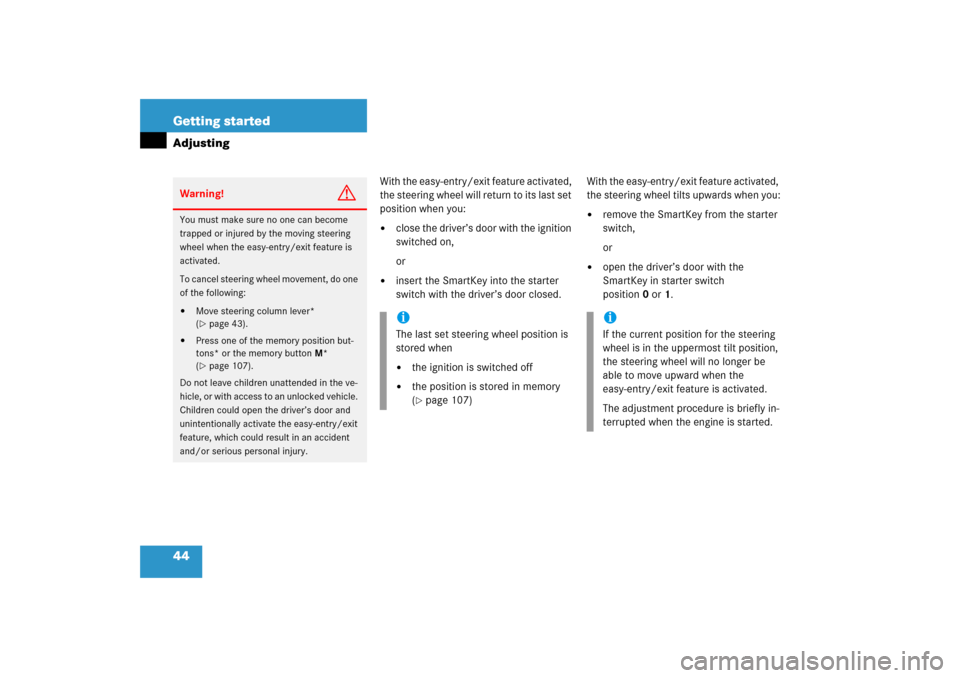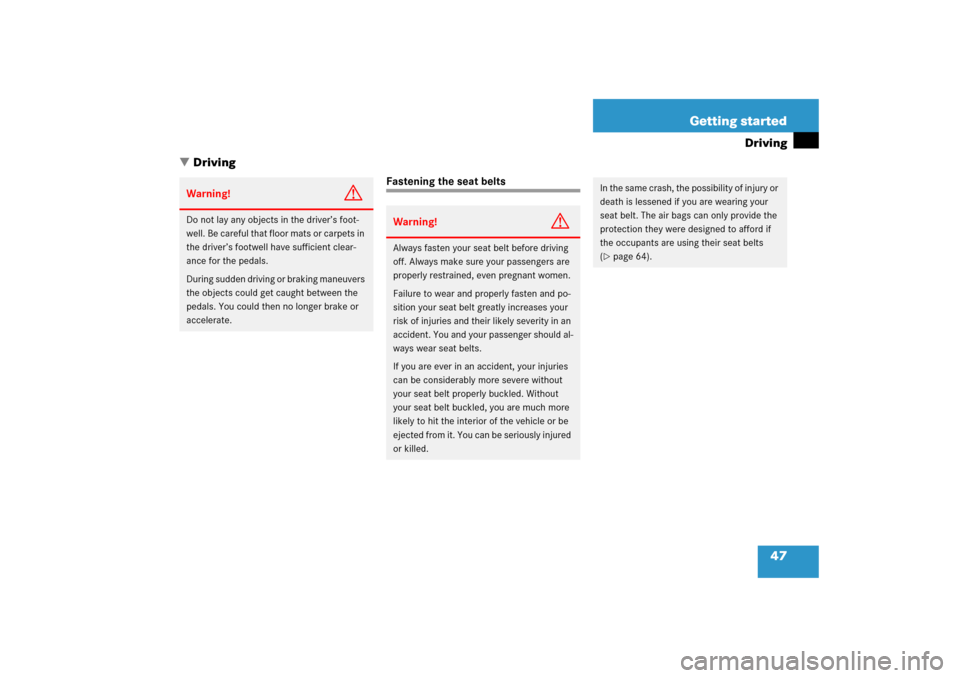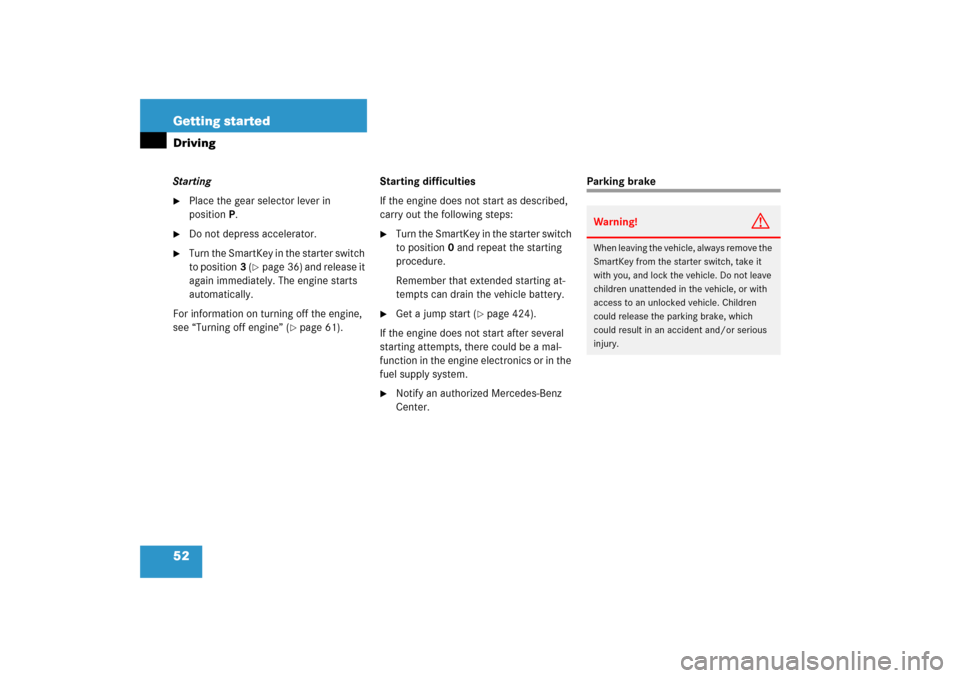Page 45 of 481

44 Getting startedAdjusting
With the easy-entry/exit feature activated,
the steering wheel will return to its last set
position when you:�
close the driver’s door with the ignition
switched on,
or
�
insert the SmartKey into the starter
switch with the driver’s door closed.With the easy-entry/exit feature activated,
the steering wheel tilts upwards when you:
�
remove the SmartKey from the starter
switch,
or
�
open the driver’s door with the
SmartKey in starter switch
position0or1.
Warning!
G
You must make sure no one can become
trapped or injured by the moving steering
wheel when the easy-entry/exit feature is
activated.
To cancel steering wheel movement, do one
of the following:�
Move steering column lever*
(�page 43).
�
Press one of the memory position but-
tons* or the memory buttonM*
(�page 107).
Do not leave children unattended in the ve-
hicle, or with access to an unlocked vehicle.
Children could open the driver’s door and
unintentionally activate the easy-entry/exit
feature, which could result in an accident
and/or serious personal injury.
iThe last set steering wheel position is
stored when�
the ignition is switched off
�
the position is stored in memory
(�page 107)
iIf the current position for the steering
wheel is in the uppermost tilt position,
the steering wheel will no longer be
able to move upward when the
easy-entry/exit feature is activated.
The adjustment procedure is briefly in-
terrupted when the engine is started.
Page 46 of 481

45 Getting started
Adjusting
Mirrors
Adjust the interior and exterior rear view
mirrors before driving so that you have a
good view of the road and traffic condi-
tions.Interior rear view mirror
�
Adjust the interior rear view mirror
manually.
For more information, see “Rear view mir-
rors” (
�page 173).
Exterior rear view mirrors
Warning!
G
Let the system complete the adjustment
procedure before setting the vehicle in mo-
tion. All steering wheel adjustment must be
completed before setting the vehicle in mo-
tion. Driving off with the steering wheel still
adjusting could cause the driver to lose con-
trol of the vehicle.
Warning!
G
In case of an accident, liquid electrolyte may
escape the mirror housing if the mirror glass
breaks.
Electrolyte has an irritating effect. Do not al-
low the liquid to come into contact with
eyes, skin, clothing, or respiratory system.
In case it does, immediately flush affected
area with water, and seek medical help if
necessary.!Electrolyte drops coming into contact
with the vehicle paint finish can only be
completely removed while in their
liquid state and by applying plenty of
water.
Warning!
G
Exercise care when using the passen-
ger-side exterior rear view mirror. The mirror
surface is convex (outwardly curved surface
for a wider field of view). Objects in mirror
are closer than they appear. Check your in-
terior rear view mirror or glance over your
shoulder before changing lanes.
Page 47 of 481

46 Getting startedAdjustingThe switches are located on the lower part
of the center console.
1Driver’s side exterior rear view mirror
2Adjustment switch
3Passenger-side exterior rear view
mirror
�
Switch on the ignition (
�page 36).
�
Press switch1 or3 to select the
respective exterior rear view mirror.
The indicator lamp in the respective
switch comes on. If you do not adjust
the selected exterior rear view mirror
by pressing adjustment switch2, the
indicator lamp in the switch will switch
off automatically after approximately
10 seconds.
�
Press adjustment switch2 forward,
rearward, left, or right according to the
desired setting.For more information, see “Storing exterior
rear view mirror parking position (parking
aid)” (
�page 108).
!If an exterior rear view mirror housing
is forcibly pushed forward (hit from the
rear) or rearward (hit from the front),
reposition it by applying firm pressure
until it snaps into place. The exterior
rear view mirror housing is now proper-
ly positioned and you can adjust the
mirror normally.
iThe memory function (
�page 107) lets
you store the settings for the exterior
rear view mirrors together with the set-
tings for the steering wheel and the
driver’s seat position.
iAt low ambient temperatures, the exte-
rior rear view mirrors will be heated au-
tomatically.!Before driving the vehicle through an
automatic car wash, fold the exterior
mirrors in. Otherwise they may get
damaged.
Page 48 of 481

47 Getting started
Driving
�Driving
Fastening the seat belts
Warning!
G
Do not lay any objects in the driver’s foot-
well. Be careful that floor mats or carpets in
the driver’s footwell have sufficient clear-
ance for the pedals.
During sudden driving or braking maneuvers
the objects could get caught between the
pedals. You could then no longer brake or
accelerate.
Warning!
G
Always fasten your seat belt before driving
off. Always make sure your passengers are
properly restrained, even pregnant women.
Failure to wear and properly fasten and po-
sition your seat belt greatly increases your
risk of injuries and their likely severity in an
accident. You and your passenger should al-
ways wear seat belts.
If you are ever in an accident, your injuries
can be considerably more severe without
your seat belt properly buckled. Without
your seat belt buckled, you are much more
likely to hit the interior of the vehicle or be
ejected from it. You can be seriously injured
or killed.
In the same crash, the possibility of injury or
death is lessened if you are wearing your
seat belt. The air bags can only provide the
protection they were designed to afford if
the occupants are using their seat belts
(�page 64).
Page 49 of 481

48 Getting startedDrivingWarning!
G
Children 12 years old and under must never
ride in the front seat, except in a
Mercedes-Benz authorized BabySmart
TM
compatible child seat, which operates with
the BabySmart
TM system installed in the ve-
hicle to deactivate the passenger front
air bag when it is properly installed.
Otherwise they will be struck by the air bag
when it inflates in a crash. If this happens,
serious or fatal injury will result.
Infants and small children must be seated in
an appropriate BabySmart
TM compatible in-
fant or child restraint system, which is prop-
erly secured with the vehicle's seat belt,
fully in accordance with the child seat
manufacturer’s instructions.
A child’s risk of serious or fatal injuries is
significantly increased if the child restraints
are not properly secured in the vehicle and
the child is not properly secured in the child
restraint.
Warning!
G
Never let more people ride in the vehicle
than there are seat belts available. Be sure
everyone riding in the vehicle is correctly re-
strained with a separate seat belt. Never use
a seat belt for more than one person at a
time.Warning!
G
Never ride in a moving vehicle with the seat
backrest in an excessively reclined position
as this can be dangerous. You could slide
under the seat belt in a collision. If you slide
under it, the belt would apply force at the ab-
domen or neck. That could cause serious or
even fatal injuries. The seat backrest and
seat belt provide the best restraint when the
wearer is in a nearly upright position and the
belt is properly positioned on the body.
Warning!
G
Read and observe the additional warning no-
tices printed in the “Safety and Security”
section (
�page 68) and (
�page 71).
Page 50 of 481
49 Getting started
Driving
1Loop for seat belt guidance
2Latch plate
3Release button
4Buckle
�
With a smooth motion, pull the belt
from the belt outlet.
�
Place the shoulder portion of the belt
across the top of your shoulder and the
lap portion across your hips.
�
Push latch plate2 into buckle4 until
it engages.
�
If necessary, tighten the lap portion to
a snug fit by pulling shoulder portion
up.
For more information, see “Safety guide-
lines for the seat belt, emergency tension-
ing device and air bag” (
�page 68).Proper use of seat belts
�
Do not twist the seat belt when fasten-
ing.
�
Adjust seat belt so that the shoulder
portion is located as close as possible
to the middle of the shoulder (it should
not touch the neck). Never pass the
shoulder portion of the belt under your
arm.
�
Position the lap belt as low as possible
on your hips (over hip joint) and not
across the abdomen.
�
Place the seat backrest in a nearly up-
right position.
Page 52 of 481
51 Getting started
Driving
Manual transmissionGearshift pattern for manual transmissionFor more information, see “Manual trans-
mission” (
�page 155).Starting
�
Depress brake pedal.
�
Make sure the gearshift lever is in neu-
tral position (no gear selected).
�
Fully depress clutch pedal.
Otherwise the engine cannot be start-
ed due to the integrated safety inter-
lock.
�
Do not depress accelerator.
�
Turn the SmartKey in the starter switch
to position3 (
�page 36) and hold until
the engine starts.
For information on turning off the engine,
see “Turning off engine” (
�page 61).Automatic transmission*
Gearshift pattern for automatic
transmissionPPark position with gear selector lever
lock
RReverse gear
NNeutral position
DDrive position
For more information, see “Automatic
transmission*” (
�page 157).
Page 53 of 481

52 Getting startedDrivingStarting�
Place the gear selector lever in
positionP.
�
Do not depress accelerator.
�
Turn the SmartKey in the starter switch
to position3 (
�page 36) and release it
again immediately. The engine starts
automatically.
For information on turning off the engine,
see “Turning off engine” (
�page 61).Starting difficulties
If the engine does not start as described,
carry out the following steps:
�
Turn the SmartKey in the starter switch
to position0 and repeat the starting
procedure.
Remember that extended starting at-
tempts can drain the vehicle battery.
�
Get a jump start (
�page 424).
If the engine does not start after several
starting attempts, there could be a mal-
function in the engine electronics or in the
fuel supply system.
�
Notify an authorized Mercedes-Benz
Center.
Parking brake Warning!
G
When leaving the vehicle, always remove the
SmartKey from the starter switch, take it
with you, and lock the vehicle. Do not leave
children unattended in the vehicle, or with
access to an unlocked vehicle. Children
could release the parking brake, which
could result in an accident and/or serious
injury.